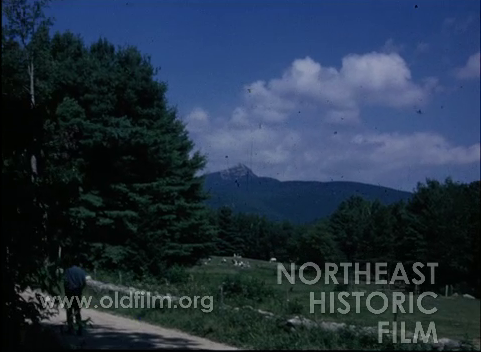by Emma Prichard
Northeast Historic Film
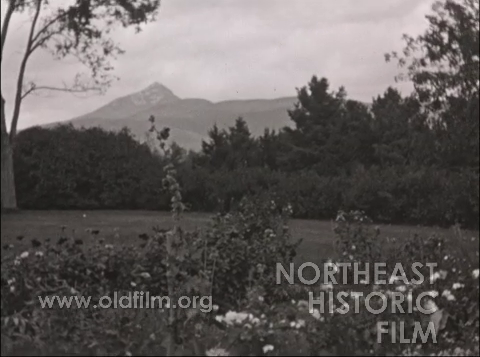
Mount Chocorua, 1930
Crossing into New Hampshire, a sharp-peaked mountain rears up out of the horizon. ‘Huh, that looks familiar,’ I think to myself as I try to calculate the distance to the next Dunkin Donuts. Of course it looks familiar, it’s Mount Chocorua. I drive past it every time I head south to visit family. It is also familiar because I have spent the last few days watching it appear on my computer screen, first in black and white, then in color. Mount Chocorua, 90 years ago, through the lens of Jeannette Peabody Cannon.
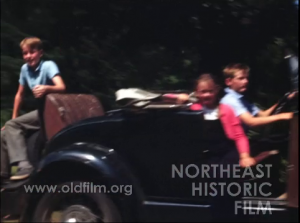
Both the mountain and the town of Chocorua, New Hampshire played a big role in the life of the Cannon family. The rural setting inspired Jeannette’s husband, LeGrand Cannon Jr., to write ‘Look to the Mountain’ a classic story of a pioneer family that brought him considerable acclaim in the 1940s. When not at their home in New Haven, Connecticut, the family was often in New Hampshire, where several generations of their family learned to swim, to ride horses, and to drive.
It can feel a bit voyeuristic, as I work my way through cataloging the collection of films created by Jeannette Peabody Cannon, and later by her son and daughter-in-law, LeGrand Cannon III and Marie Cassidy Cannon, watching a collection of films in twenty-minute segments that span 50 years of weddings, first steps and road trips. It’s also a lot of fun. The familiar, the historical and the new, all through the lens of one family’s memories.
In addition to containing views of my familiar New England stomping grounds, the collection also depicts scenes from around the world. A reel of 16 mm film marked: ‘London and Paris 1929’ revealed a collection of black and white footage of Rome, Venice and Lake Como from the 1920s. Other reels showed Florence and, finally, the shots of London and Paris promised on the can labels.
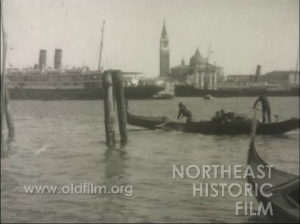
Venice, 1929
Part of cataloging, particularly with cataloging film, is recording the locations featured in the work. At Northeast Historic Film, this is done using the Georeference field in Collective Access. Collective Access uses a combination of the GeoNames database and Google Maps Geocoding, so that a cataloger can enter the latitude and longitude (or to simplify things, just the name) of a place, and it will map the location. Cities, parks, and landmarks are easily named and made visible on the map.
Many of the films in NHF’s collections come with donor notes. They are often faded, hand written notes with family inside jokes in the margins, or can labels which might include the date and location that the film was made. Sometimes the labels have been switched, are incomplete, or are simply wrong. Sometimes there are no notes to add context to the films. This is where Google Maps is invaluable.
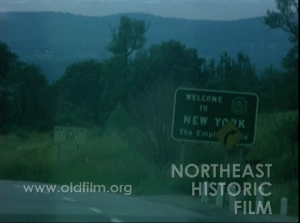
Thanks to Google Maps, Google Images, and social media sites like Instagram and Pinterest, it is possible to find, not only the city that a film was shot in, but the exact street corner. Following the Cannon family, I compared ‘then and now’ shots of the Spanish Steps, hunted for a lion on street view through Trafalgar Square (Nelson’s Column), walked along the Seine (keeping an eye out for Hemingway and Fitzgerald) and spent (probably too much) time looking into the history of a missing statue in Florence. (Statue of Daniele Manin, moved in 1931.)
Thirty years later, and in color, LeGrand Cannon III and Marie crisscrossed North America on numerous family road trips. Conveniently for the cataloging process, they filmed every ‘Welcome to insert state here’ and ‘Historic Home of insert dead person’s name here’ sign that they passed. Every. Single. One. The georeference lists for those reels are a bit long.
Alongside the family scenes, there are some interesting snap shots of history. Classic images of now retired steam ships. LeGrand Cannon III visiting the 1964 New York World’s Fair. A Fourth of July parade for the United States bicentennial in 1976. And towards the end of the collection, a few final shots of the house in Chocorua, and the mountain beyond.
